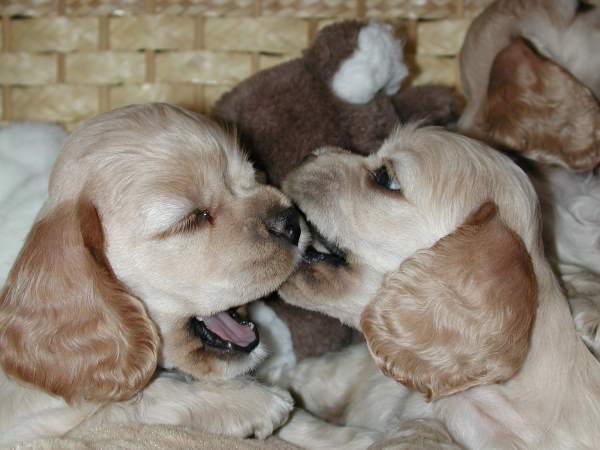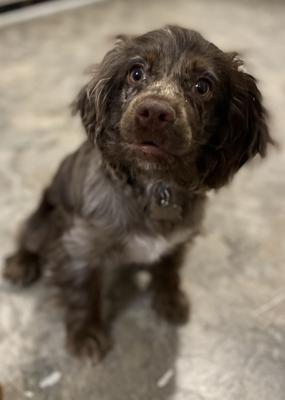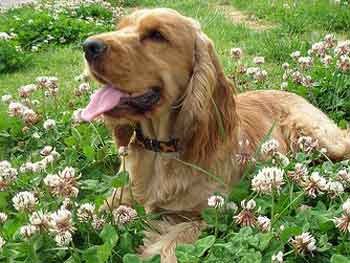- Home
- Cocker Spaniel Puppy Care
- Grooming a puppy for the first time
How grooming a puppy early will help get him ready for the real deal!
I'm often asked, "When's the best time to begin grooming a puppy?"
My answer is always the same, "The sooner, the better!"
Why?
Grooming a puppy before he actually needs it will help him feel comfortable with everything he may encounter on the groomer's table.
Grooming also helps you to bond with your new puppy. It can help relax your dog, and because it's so 'hands-on', it will help your little boy get used to being handled too!
So when it's time to visit the groomer, he'll be a relaxed, happy Spaniel!
What's Involved With Grooming A Puppy?
You're probably wondering what you're supposed to groom because your puppy won't develop feathering until he's about six months old. So at this stage, you're not really grooming him; you're simply going through the motions, which will,
- Help your puppy get used to being handled by humans. Having his paws and ears touched and all his 'important little bits' will mean there are no surprises when he gets onto the grooming table!
- Help familiarise your puppy with grooming tools. If you've done your job right, your puppy won't be startled by the sound of clippers or scissors. He'll be familiar with a range of brushes and combs, making it highly likely that he'll sit quietly on the grooming table.
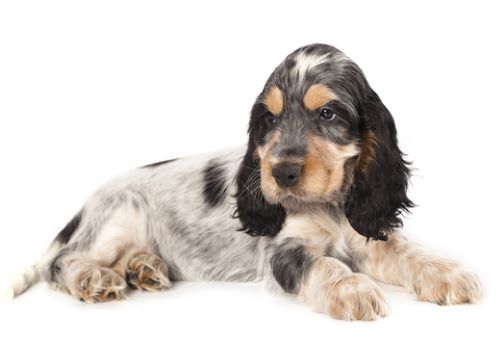 Cocker spaniel puppy, relaxed and freshly groomed!
Cocker spaniel puppy, relaxed and freshly groomed!- Early grooming can help you form a strong bond with your puppy and relaxes both owner and puppy (or it should!).
- It can help you spot early signs of health problems, for example, skin eczema, infection, skin damage and parasites.
Begin grooming a puppy as early as possible, and it will pay dividends when your puppy's coat grows long enough to need grooming for real.
A puppy familiar with grooming procedures and tools will be a happy little boy; no tears or tantrums; that's what I call a result!
Grooming A Puppy For Best Results!
Okay, we've established that it's best to begin grooming your puppy right from day one. Now we need to take a look at how it's done.
Make Sure You Have Everything You Need Beforehand!
Make sure you have all the puppy grooming tools you'll need for your grooming session before you begin.
You'll need cotton wool or buds, a soft puppy brush, a metal comb, and scissors.
A bowl of water, tweezers and a towel may come in handy too.
If you plan on trimming your Cocker, have the electric trimmer to hand too. Don't worry; you won't use it on your puppy yet.
Brush Your Cocker Spaniel Puppy
Your puppy will be on a table when he's professionally groomed, so it's best to start by having him elevated when you familiarise him with grooming activities. Just make sure you don't leave him up there alone or unsecured in case he falls and hurts himself.
I recommend placing a bath mat on the table so your puppy won't slip about.
- Brush your puppy gently, from head to tail, with a soft bristle brush.
- Then use a metal comb or pin brush (also called a slicker brush) gently comb his ears and legs. Be gentle with these; they can scratch delicate puppy skin if you exert too much pressure.
- If there are any knots or tangles, try to tease them out with your fingers or the end of the metal comb.
'Trimming' Your Cocker Spaniel Puppy
- The sound of snipping scissors can often 'spook' a dog. You can help your puppy get used to this sound by pretending to cut your puppy's fur around his paws and ears with a pair of blunt round-ended scissors.
If he gets used to this sound while he's very young, you should have no trouble when your pup is older; he'll sit quietly and allow you to trim him (well, that's the theory!). - If you have an electric trimmer or razor, place it on the table (unplugged) and let him sniff it. Leave it lying on the table while you work through the grooming process.
When he's used to seeing the trimmer lying around, you could switch it on occasionally to help him get used to the sound so that when (and if) you take him to the groomers, he won't be afraid of the noise the trimmers make.
Don't switch them on right in front of his face; otherwise, you may startle him.
Your Cocker Spaniel Puppy's Paws and Claws
Dogs can be very sensitive about having their paws handled; that is why you need to get your Cocker Spaniel puppy used to this at a very early age.
Doing these exercises below will get your puppy used to having his feet handled, which is very important.
Desensitise Your Puppy's Paws
Begin by picking up each paw and stroking them gently.
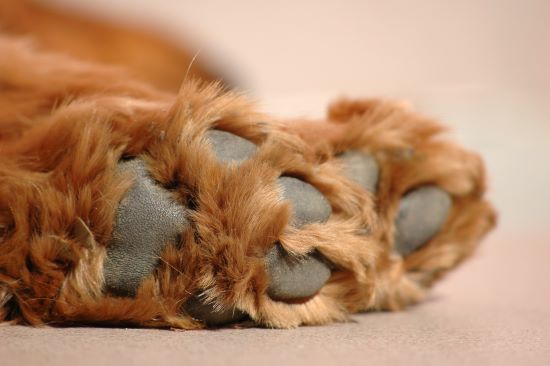 Grooming a puppy? Don't forget his paws!
Grooming a puppy? Don't forget his paws!Examine Your Puppy's Paws
Examine your puppy's paws. Seeds, sharp grasses, twigs etc., often get caught between the toes or pads of their feet, and if these aren't found and removed, the sharp seeds may work their way into your dog's skin which will be painful for him and could lead to infection.
When grooming a puppy, you must check the fur between his paws regularly to ensure nothing is trapped in there that could cause pain for your puppy. Even matted fur between the pads can cause pain, so keep the fur growing on the underside of the paws trimmed level with the pads.
Never remove the fur between the pads; your puppy needs this to protect his paws.
Grooming A Puppy: Comb His Paws, Gently
Gently comb your Cocker Spaniel's paws. He needs to get used to the feel of a steel comb between his toes, but be very gentle as this can be an extremely sensitive area.
Gently Squeeze Your Puppy's Paws
When you think your Cocker Spaniel puppy is becoming used to having his paws handled, hold each paw, one by one, in both hands and squeeze very gently.
Lift Your Puppy's Nails
Carefully lift each nail, in turn, between your finger and thumb; praise your puppy if he doesn't pull his paw away.
Repeat this and the above exercise daily until your puppy is happy to let you examine his paws without objecting.
Grooming A Puppy: Trimming His Puppy Nails
Your new baby won't need his nails trimming just yet, but now is the time to acclimatize him to the sight, feel and sound of nail clippers, scissors, and nail file.
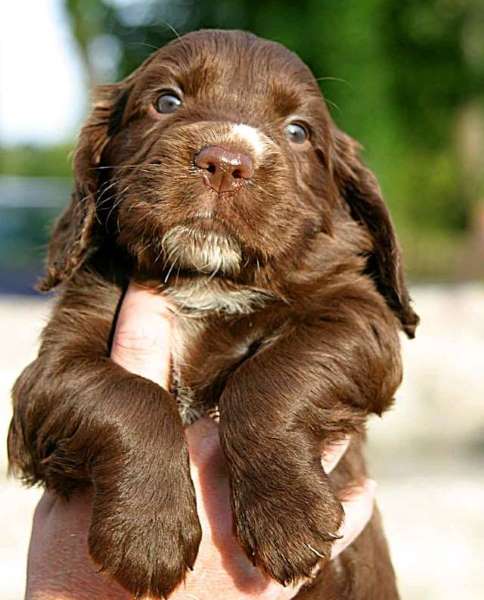 How cute is this cocker spaniel puppy?
How cute is this cocker spaniel puppy?By the time your Cocker Spaniel puppy is ready to have his nails clipped, he'll be used to having his paws handled, and it will quickly become part of his grooming routine.
Without these preparatory exercises, you don't even want to think about his behaviour when it's time to clip his nails! The words 'Tasmanian devil' spring to mind!
Follow this link, which explains all about cutting your dog's nails. When you've read the article and feel confident enough, you could begin by snipping a tiny amount from only one nail each day before gradually working up to all four paws.
If your puppy stays still, praise him and treat him occasionally.
If you're not confident about the procedure, why not ask your vet or groomer to show you how before you try it yourself?
Grooming A Puppy: Cocker Spaniel Eyes
Gently clear away any sleep from your puppy's eyes with damp cotton wool.
Do this daily if necessary, and use a separate piece of cotton wool for each eye to avoid the possibility of transferring infection from one eye to the other.
If you'd like to brush up on health problems that could affect your dog's eyes during his lifetime, follow the link.
Grooming A Cocker Spaniel Puppy: Cocker Spaniel Ears
Handle your puppy's ears as often as you can. That won't be too difficult to do, will it?
Cocker Spaniel ears are adorable!
Examine your puppy's ears, smell them (they should smell of puppy and nothing else), and keep them clean.
You can do this using a lightly moistened cotton bud but do not push the bud into the ear canal, as this could seriously damage your puppy's ear. Use a separate cotton bud for each ear to avoid cross-infection.
You can learn how to clean your Cocker's ears and spot the signs of infections in your puppy's ears here.
Grooming A Puppy: Dental Care
Gum disease can be excruciating and lead to tooth loss and other health problems, so checking your puppy's teeth regularly for signs of gum disease or other health problems is essential.
The main point here is to get your Cocker Spaniel puppy used to having his mouth and teeth inspected. It will be much easier for you both when he's older.
Check your puppy's gums once each week. They should be a healthy pink colour. If your pup has terrible breath or his gums appear pale or red and swollen, I recommend you take him to the vet.
Grooming A Puppy: Brushing Puppy Teeth
Help keep your puppy's teeth clean by brushing them daily (or at least two or three times a week if you don't have the time).
- Begin by gently rubbing your finger over your puppy's teeth and gums. There's a good chance he'll not be too happy with this, but I recommend you persevere.
- If he refuses to open his mouth, you could dip your finger into some beef or chicken stock - that might do the trick!
- Dental sticks can help to keep your puppy's teeth clean and tartar free, and you can pick these up pretty much anywhere, even at your local supermarket.
- Feeding your dog dry food (kibble) will also help to keep his teeth clean.
When your pup doesn't mind his teeth and gums being rubbed, you can try to introduce a toothbrush and a little toothpaste.
You can buy puppy toothbrushes and toothpaste from most good pet stores or your vet. Don't be tempted to use toothpaste meant for humans as it froths up too much and can upset his delicate stomach if swallowed.
You can learn more about brushing puppy teeth and how to brush adult dog teeth here.
Examine Your Puppy's Bottom
Check your puppy's bottom area to make sure he's clean and that his bottom looks healthy. Use a cotton wool ball moistened with warm water to clean him if necessary.
All dogs can suffer from impacted anal glands at some point which can be especially painful if infection occurs; however, a good healthy diet which produces firm stools will go a long way to keeping your dog's anal glands healthy.
Grooming A Puppy: Tactics For Success!
- Be gentle with your puppy at all times and speak quietly to him to reassure him.
- If he's good, praise him. Try not to reprimand him too much if he wriggles; carry on regardless; otherwise, he may resent being on the grooming table.
- If your puppy objects to being manhandled, be firm (but not rough) and continue grooming him. Don't stop; otherwise, he'll learn that you'll stop if he squirms, yelps, or misbehaves (delete as necessary).
However, if he becomes stressed, try to lighten up a little and make it fun. If that doesn't work, stop and try again later. - If he tries to bite your fingers, correct him with a firm "No" in a disapproving tone and carry on regardless. Although it's better to praise your dog (when he's good or quiet) than to 'punish' him, he must learn that biting is unacceptable.
Grooming A Puppy: Summary
Thankfully, we don't have to accomplish the entire grooming routine at this young age because he still has his puppy coat, and his feathers probably still need to develop.
The whole point of early puppy grooming sessions is to take your puppy through the motions of grooming to help him become familiar with grooming tools, being handled, brushed, combed and examined.
It shouldn't take too long; just a few minutes each day is all you'll need for now, and I promise it will pay dividends in the long run!
All we need to do is get him used to the handling process and the grooming tools we'll use when he's older.
However, it's essential to establish and maintain control right from the beginning. Show your puppy that you won't stand any 'nonsense'.
Take things slowly and gently, praise him if he behaves, but give him 'time out' if he gets too anxious. Grooming is supposed to be a relaxing and happy time for you both.
And for future reference, this is how to groom an adult Cocker Spaniel.
Have fun!
Photo credits for Grooming a puppy:
1. Liliya Kulianionak at https://www.dreamstime.com/stock-photography-family-english-cocker-spaniel-dogs-image23621952
2. Benedeki at https://www.freeimages.com/photo/dog-foot-1358557
3. Rob Waterhouse at https://www.freeimages.com/photo/sussex-spaniel-puppy-1-1386993



